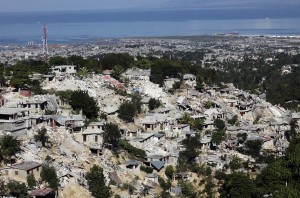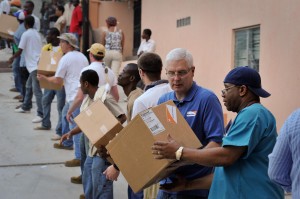Port-Au-Prince, Haiti – 365 days ago the morning started like any other. The sun rose, the roosters crowed, the people greeted the day. But for 35 seconds late in the afternoon the earth grumbled and trembled and the lives of the Haitian people changed forever.

A 7.0 magnitude earthquake hit the Haitian capital of Port-Au-Prince and surrounding area shortly before 5pm on Tuesday, January 12, 2010. The earthquake, the most devastating in 200 years, affected roughly three million men, women and children. Entire communities were reduced to rubble. Millions of people lost their homes, schools, hospitals, jobs and, most tragically, their loved ones. The powerful earthquake left the country in chaos and in desperate need of help.
Widespread damage – including destruction of roads, hospitals, schools and government buildings – made relief efforts extraordinarily difficult. But regardless, within 24 hours, relief organizations such as World Vision, The Red Cross, UNICEF, Salvation Army and others jumped in to bring assistance to Haiti. Distributing emergency supplies, food, water, and setting up temporary shelters.
UNICEF has been a development partner in Haiti for over 60 years. With expertise in nutrition, education, child protection and water sanitation and hygiene, UNICEF led the large-scale emergency response for children and families.
In the hours that followed the earthquake, Haitian Red Cross volunteers and staff around the country took immediate action to save lives. Focusing on those in greatest need, the Red Cross sent 21 emergency response units, providing Haitian communities with medical attention, shelter, clean water and essential emergency relief items.

World Vision had been in Haiti for 30 years prior to the earthquake. After the earthquake hit, they had 600 World Vision staff on the ground making sure that relief was getting to the people who needed it most. World Vision had relief items stored in Haiti in preparation for the hurricane season and were able to distribute these supplies quickly. Over 18 million tons of additional relief supplies were also distributed by World Vision staff. Supplies included: shelters, blankets, collapsible water containers, hygiene kits and cooking sets.
When the earthquake struck Haiti, members of the local Salvation Army – themselves victims – quickly mobilized to share their meager resources with those in such great need. The Salvation Army has had a long and established record of exemplary service in Haiti, which began in 1950 and is now both widespread and diverse in nature.
HAITI UPDATE: one year later
- Three million people are affected, (OCHA) including 1.5 million children and youths under 18 (UNICEF), out of a population of 9.8 million. (UNICEF, 2008)
- More than one million people are left homeless. (AlertNet)
- The earthquake leaves 222,570 dead and 300,572 injured. (Govt. of Haiti)
- 105,000 homes are destroyed and more than 208,000 damaged. (Haiti Earthquake Post-Disaster Needs Assessment)
- More than 1,300 educational institutions and more than 50 hospitals and health centres are collapsed or unusable. (Haiti Earthquake Post-Disaster Needs Assessment)
- 60% of the government, administrative and economic infrastructure in Port-Au-Prince is destroyed. (UNICEF, 2010)
- 52% of households are food-insecure; one-third of households have lost their entire food supply. (Haiti Earthquake Post-Disaster Needs Assessment)
- An influx of displaced people into rural areas puts an unprecedented level of strain on rural households, decreasing their standard of living and leaving them more vulnerable to external shocks such as sudden price increases. (FAO, 2010)
- World Vision finds that on average less than half the households in surveyed rural regions have sufficient access to water for drinking and household needs. (World Vision Baseline Survey, May 2010)
HAITI 2011: a nation recovering
- The United Nations Humanitarian Country Team includes 26 organizations implementing earthquake response programs.
- Eleven “clusters,” or interest groups of humanitarian organizations, enhance coordination, information-sharing and response standards.
- Food, clean water, shelter, sanitation, health, child protection, livelihood and education assistance are prioritized for communities.
- The socio-economic situation remains fragile, with more than one million people still displaced.
- As of mid-December 2010, a cholera outbreak had claimed more than 2,100 lives, with some 47,000 persons hospitalized.
- Children under 5 remain susceptible to developing short- and longterm illnesses.
- By December, a total of 19,000 transitional shelters had been built by all aid groups operating in Haiti.
- Land tenure issues pose a challenge in shelter reconstruction.
- The Interim Haiti Recovery Commission is in place to develop and refine Haiti’s development plans, assessing needs and gaps for investment and ensuring that the implementation of plans is coordinated, effective and transparent.
Many challenges lie ahead in the reconstruction and transformation of Haiti. Due to the complexity of the crisis, and the compounding impact of cholera, the relief phase is still far from over, even though some recovery work has begun.
World Vision has committed to a minimum five-year earthquake emergency response. The organization had been present in Haiti for three decades prior to the disaster and will continue to initiate and expand long-term development programs that encourage well-being, especially of children and vulnerable groups.
UNICEF will remain a partner in Haiti for the long run, they are committed to helping strengthen and expand systems and services that protect the rights and well-being of children in the long term. With sustained support and a collective vision, they can ensure that children born today not only survive, but thrive in a Haiti fit for children. Nutrition, education and protection remain UNICEF’s priorities and are the key to the transformation of the nation and of children’s lives. Facilitating durable solutions for the return of displaced people – the majority of whom were among the poorest of the poor before the earthquake – is also key. Protecting children and families against the impact of cholera remains a full organization-wide priority as we begin 2011.
The Red Cross is committed to supporting communities in Haiti, today and in the years to come. Careful planning has begun and the Red Cross is now shifting from providing emergency relief to the more complex task of helping communities rebuild and restore their lives.
With more than 6,000 members in Haiti, The Salvation Army is well placed to continue its ministry to those in need as work in Haiti begins to transition from emergency disaster responses to long-term redevelopment. There are presently more than 9,000 students in 49 primary schools operated by The Salvation Army throughout Haiti. In addition, they operate several children’s homes and secondary schools. The Army’s medical work includes maternity programs, dispensaries, tuberculosis clinics, primary health care centres, a nutrition centre and medical aid for the ongoing cholera outbreak.
Article is special to NetNewsledger.com written by Lily Korhonen. Also featured on www.thesleepinggiant.ca for updates, information and events and much more about the Thunder Bay region.
